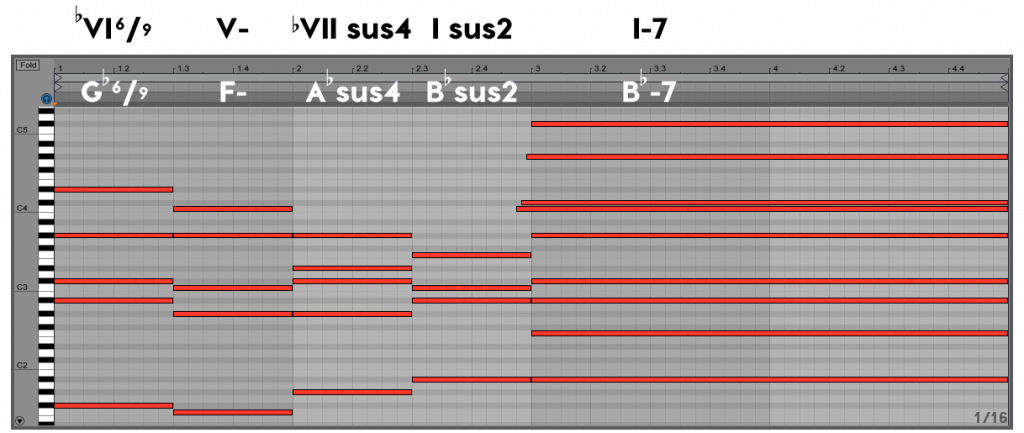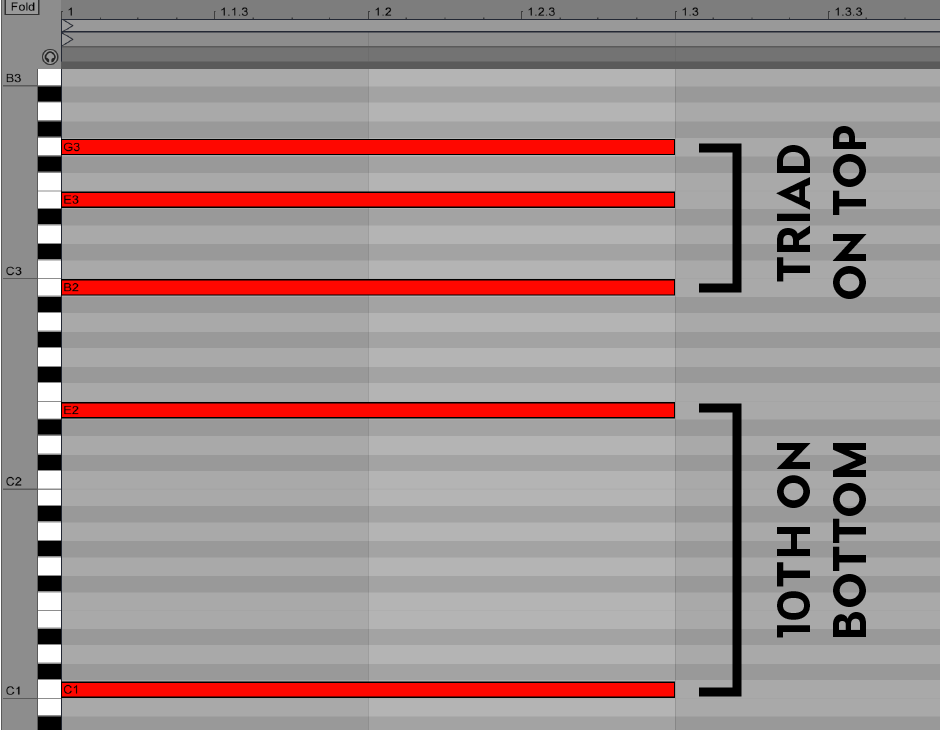In this article, we’re going to be exploring how to use different voicings of seventh chords to create progressions that sound bigger, wider, and more complex than your average pop chord structure. If you need a refresher on how to build a basic seventh chord, read this article or watch the video below. (For all you electronic producers out there, we’ll be using the piano roll in Ableton Live to show you just how easy it is to complexify your chord structures, even in MIDI.)
The above video is taken from Soundfly’s popular six-week mentor-driven online course, Unlocking the Emotional Power of Chords, but the following lesson is taken from its more advanced sibling course, The Creative Power of Advanced Harmony.
Alright, so now that you know how to create all kinds of sevenths chords, let’s look at how Björk uses them in her song, “Arisen My Senses.” And examine how we can play around the voicings of these chords to make them sound even bigger, richer, and bolder!
One thing you might have noticed about this song is that at the most basic level, the progression is fairly simple:♭VI V– ♭VII I–
That’s all diatonic to a natural minor scale.

But the other thing you might have noticed is that the sound is so much richer and more complex than this very basic form of the progression provides. That’s in part due to the big open voicings she used!
As a songwriter or composer, how we choose to voice our chords (or distribute the notes in the chords) can have a significant impact on the sound we create. Closed voicings (which are built by simply stacking the chord tones in order) sound tighter and more clustered, like a little shot of tones, whereas open voicings (where the notes are distributed in a wider way) can give us big, lush, and varied sounds.
Let’s quickly look at a couple of easy types of voicings that as a producer you might use to craft your seventh chords across instruments or voices.
Root Position
This one should be familiar to you, as it’s basically the default way to write a chord. You simply start at the root, and stack the remaining notes in order. Technically, root position voicings are closed. Like we mentioned a second ago, when we build a closed voicing, we’re just stacking the chord tones in the order in which we encounter them.
On the other hand, in an open voicing, we’ll sometimes move a note to a new register, spreading things out across more territory. Rather than stacking C, E, G and B for a CMaj7, we might play C, then move up a fifth to G, then play the E above that, and finish our voicing with the B above that. We’ll take a closer look at that example later on.
Third on Top
This chord has been voiced in such a way that we now have the third of the chord as our top voice. Rather than simply being played in root position, our CMaj7 now looks like this:

Notice that root and fifth in the bass, anchoring the chord. If you took Unlocking the Emotional Power of Chords, you may notice that by itself, this is a power chord. The root+fifth combo is a really solid sound, that grounds things without creating any clashes, so it’s incredibly versatile.
Most bass players know the root+fifth relationship all too well, and with good reason. It has a lot of strength on its own, can be combined with other notes without too much risk of clashing, and can be played quite low without sounding overly muddy.
Looking back at our voicing, notice that the more colorful, “character defining” notes are voiced higher — the third and the seventh. We can think of these two notes as being largely responsible for the chord’s overall sound or character. What quality of seventh chord we have basically comes down to what kind of third and seventh we’re using. In this case, that E is a major third, and the B is a major seventh. These notes are super important, and likely to appear in the melody, or other layers of the track. So if you’re hoping to support a vocal or other featured sound, having character notes in a similar register might not be a bad idea. For instance, this voicing would be a great one to try under a third in the melody.
This voicing is still sort of tight, but we’ve spaced things out, so it’s a little wider than a closed voicing would be.
Seventh on Top
In this next voicing, we’re spreading things out even more, to create a wider sound by simply leapfrogging our seventh above the third:

Now we have the bass note almost two octaves below the highest note, so we’re covering a lot of territory.
The seventh on top can sometimes be a little bit of an edgy sound, and you probably wouldn’t want to use this if you had the root of the chord in the melody. Looking at our example, think about how close B and C are to one another if you move the C to the top. Since they’re side by side like this, having a B in your top line could make it difficult for a singer to really distinguish and sing a C in the melody, so there’s a chance their performance would be a little pitchy.
That very thing is all the more reason to use this to support a seventh in the melody though.
The other cool thing about this voicing, is that it basically gives you two power chords stacked on top of each other, which can be an interesting idea to explore in your arrangements. You could try giving C and G to one sound, and E and B to another — creating two independently strong parts that fit together to create your chord.
Sidenote: In voice leading (or how you arrange your notes horizontally across multiple chords), the goal is basically to have each voice (or horizontal path) move as smoothly as possible. Sometimes that means sustaining notes across chords, sometimes it means moving in very small intervals. For instance, if you were in the key of C, moving from a CMaj7 (I) to an FMaj7 (IV) the third on that first chord, E, is also the seventh on your second chord. No matter where that E was in your first voicing, there’s a very good chance you’d want to keep it in the same spot for your second voicing.
Shell Voicings on the Bottom
A shell voicing is somewhat similar to the root+fifth situation from earlier. In this case though, you’ll want to pair your root with one of those character notes — the third or the seventh. Because we’ve included one of those critical notes here, it’s a little less ambiguous than that power chord sound was, but it still gives you plenty of freedom to do what you want in the higher register.
This type of voicing is super popular among jazz pianists. It was a staple for bebop musicians like Bud Powell, who would often use shell voicings in his left hand while his right was free to solo at will.
Let’s look at our CMaj7 again.

This time, we’ve stacked our notes from C to B, to G to E. Again, having that E on the top is a particularly great choice if you also have an E in the melody.
Since we’re thinking like producers, chances are we won’t just be sustaining those four notes for the exact same duration. Maybe the rhythm of whatever’s playing the higher notes is a little varied, or maybe those pitches are part of a more elaborate melodic phrase. Either way, by having the C and B as a foundation, we can continue to imply that this is a CMaj7, without having to consistently sustain all four notes in the chord.
Having C and E on the bottom would have a similar effect.
One thing to note, is that you won’t want to use this one in a super low register, as it tends to get muddy-sounding. This is related to a concept called “low interval limits” that we won’t really get into here, but the basic idea is that there’s a point at which using an interval becomes a little dicey. This has to do with the overtone series, and how different frequencies interact with one another.
Octave or 10th in the Bass
One way to avoid low interval limits is to use either octaves or 10ths in the low-end of your voicing, and then add the other notes on top, possibly even a triad. That big 10th interval is just a third spread further out, so it’ll imply a lot about the chord, but in a more open way than a simple third on the bottom might.

The octave is pretty much fair game. It sounds great, doesn’t clash, and doesn’t have any key guidelines tied to it in contemporary music. It’s also a form of doubling, which is the last thing we’ll mention for now.
Doubling Notes
Like all of this, there are no real hard and fast rules for choosing which notes to double in a voicing. There are, however, some things to consider that might help steer things in a direction you’re happy with:
- The root is a safe choice 99.9% of the time, particularly in that lower register like we just mentioned.
- Melody notes are also a really strong choice, particularly if you’re hoping to support your featured voice or instrument.
- Character notes can sometimes be doubled to strengthen the quality of the chord. This is definitely something to consider when we move into mode mixture.
- Fifths are a surprisingly unimportant note a lot of the time, so they aren’t necessarily the best candidate for doubling. In fact, if you’re using sevenths and other extensions, you can even leave the fifth out completely a lot of the time and still maintain the overall sound of the chord — something to consider if you have more notes than available voices or instruments.
Keep Going!
There are tons of other voicing options that partially depend on the range of the instruments you’re using. If you’re like us, you’ll find that playing around with different voicings is one way to get the most out of these thicker chords and really make the color shine through.
I mean, we didn’t even mention what happens when you decide to leave the root note out of the bass… are you brave enough to try it?
Want to get all of Soundfly’s premium online courses for a low monthly cost?
Subscribe to get unlimited access to all of our course content, an invitation to join our members-only Slack community forum, exclusive perks from partner brands, and massive discounts on personalized mentor sessions for guided learning. Learn what you want, whenever you want, with total freedom.




